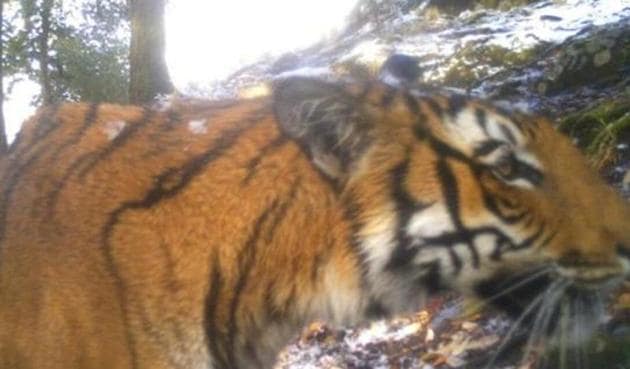In search of elusive high-altitude tigers, India, Nepal and Bhutan fall back upon camera traps
The International Union for Conservation of Nature (IUCN) will conduct the project in the three countries, with the Global Tiger Forum (GTF) and Dehradun-based Wildlife Institute of India (WII) playing a crucial role in synchronising the programme.
Camera trapping is likely to be used by next year to look out for tiger habitats at an altitude above 10,000 feet in India, Nepal, and Bhutan, experts associated with the project said.

The International Union for Conservation of Nature (IUCN) will conduct the project in the three countries, with the Global Tiger Forum (GTF) and Dehradun-based Wildlife Institute of India (WII) playing a crucial role in synchronising the programme. To start with, experts will do the homework based on facts available this year.
At the second consultative meeting under the project, organised in the capital on Friday, experts held discussions to devise a time framework for identifying tiger habitats. Camera traps will be used in identified locations after action plans of the three countries are submitted by early next year, experts said.
The first meeting under the project was held in Bhutan early this month.
“Evidence of tigers above 10,000 ft, key wildlife and tiger habitat, and contours of tiger presence are the three mandates on which the project will work. We aim at coming up with a map on tiger presence in high-altitude areas for better conservation strategy for all three countries,” said Rajesh Gopal who heads GTF.
In India, tiger presence was reported at 10,700 feet altitude in Askot in 2016, besides Kedarnath and Tehri. Arunachal Pradesh and Sikkim have also reported presence of big cats at this elevation. WII experts believe tigers could be present in high-altitude areas of Bhutan and Nepal.
India has 2226 tigers, according to the All India Tiger Estimation, 2015. A 2013 estimation put tigers’ numbers in Nepal at 198; Bhutan has 103 tigers, according to the National Survey Report.
WII experts decide a grid pattern for camera traps and fields for better implementation of the system. “The general grid pattern will be 15kmX15km, which will be divided into smaller grids of 5kmX5km. This specific grid pattern will help synchronise the research on the ground,” said K Ramesh, senior expert with WII.
“Camera trapping above 10,000 ft is unlike routine monitoring. So, we will do sample camera trap survey in probable sites based on prior knowledge and information,” he said. The modern camera trap is a digital camera connected to an infrared sensor which can see moving objects like animals.
This year, experts and authorities of each country will assist WII experts in gathering available data, camera trap records, working plans and gazetteers to study the presence of tigers.
The role of locals will also be significant. “Locals can share a great deal of information. Whether recent spotting or historic, their leads could be beneficial to the countries,” said Nishant Verma, deputy inspector general of forest with the National Tiger Conservation Authority (NTCA).






